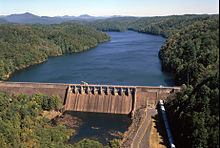| Apalachia Dam | |
|---|---|
 | |
| Official name | Apalachia Dam |
| Location | Cherokee County, North Carolina, United States |
| Coordinates | 35°10′4″N 84°17′44″W / 35.16778°N 84.29556°W |
| Construction began | July 17, 1941 |
| Opening date | February 14, 1943 |
| Operator(s) | Tennessee Valley Authority |
| Dam and spillways | |
| Impounds | Hiwassee River |
| Height | 150 ft (46 m) |
| Length | 1,308 ft (399 m) |
| Reservoir | |
| Creates | Apalachia Reservoir |
| Total capacity | 57,800 acre⋅ft (71,300 dam3) |
| Catchment area | 1,018 sq mi (2,640 km2) |
Apalachia Dam is a hydroelectric dam on the Hiwassee River in Cherokee County, in the U.S. state of North Carolina. The dam is the lowermost of three dams on the river owned and operated by the Tennessee Valley Authority, which built the dam in the early 1940s to provide emergency power for aluminum production during World War II. While the dam is in North Carolina, an 8.3-mile (13.4 km) underground conduit carries water from the dam's reservoir to the powerhouse located 12 miles (19 km) downstream across the state line in Polk County, Tennessee.[1] The dam and associated infrastructure were listed on the National Register of Historic Places in 2017. Apalachia Dam is classified by the U.S. Army Corps of Engineers as a high-hazard dam, meaning a dam failure may pose a deadly threat to nearby residents. The dam's condition is not made available to the public due to security concerns.[2][3]
Apalachia Dam is named for the crossroads community of Old Apalachia, located near the dam site in North Carolina, and the community's L&N railroad stop, known simply as Apalachia, which was further downstream on the Tennessee side of the state line.[1]
- ^ a b Tennessee Valley Authority, The Hiwassee Valley Projects Volume 2: The Apalachia, Ocoee No. 3, Nottely, and Chatuge Projects, Technical Report No. 5 (Washington, D.C.: U.S. Government Printing Office, 1948), pp. 1–13, 33, 34–35, 331, 493–494, 517, 526, 531.
- ^ "Apalachia Dam". National Inventory of Dams. 2021-06-15. Retrieved 2024-10-25.
- ^ LIEB, David A. (2022-05-05). "Condition of some US dams kept secret in national database". Associated Press. Retrieved 2024-10-25.